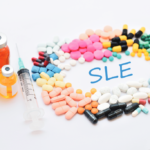Approved in 2011, belimumab is the only new FDA-approved drug for lupus in more than 60 years. Prior to that, the only approved drugs for lupus were steroids, antimalarials and aspirin.
“If you tried to take care of lupus patients with just steroids, antimalarials and aspirin,” says Dr. Merrill, “you’d be committing malpractice. So we end up borrowing drugs from other diseases that haven’t been studied all that well for lupus, and, aside from belimumab, that’s our standard of care.”
Personalized Medicine
Lupus, a heterogeneous disease that presents clinically with a large variety of symptoms and comorbidities from patient to patient, can be enormously complicated to treat. “When you try to [use] biomarkers or blood tests to figure out the difference between these patients, what you find is that they usually have overlapping features and they often have unique features,” Dr. Merrill says.
One of the ways researchers are beginning to approach this problem is to study the activation of immunologic pathways in large populations of lupus patients. “Heat maps showing the expression of large arrays of genes give us complex geographic maps as the body begins to respond to different immunologic triggers,” Dr. Merrill says. “We are getting better at sorting this into interpretable patterns and, thus, clustering our patients into meaningful subsets.” Eventually these patterns may become helpful in deciding which drugs to try first for which patients.
“A lot of people feel like this is not worth doing, because you’re never going to get it perfect, and I won’t be able to tell my patient who walks into my office, ‘I’m putting you on this drug and it’s definitely going to work for you,’” Dr. Merrill says. “But if I walked into a doctor’s office and I was told, ‘I’m not going to bother. I’m just going to give you any old drug because we can’t figure it out,’ I would say, ‘Well, can you guess better?’”
Dr. Merrill suggests that if rheumatologists could tell patients they have a 70% chance of responding to a particular drug rather than a 40% chance, this would improve medical care in a profound manner. “So that’s where we are. We’re trying to get to 70%,” she says. “We’re probably not going to get to 100% in the near future, but we’re trying to get to 70%.”
In fact, decreasing the uncertainty of treatment selection may enable physicians to better defend the decision to try an expensive new treatment with a particular patient as it comes on the market. “I think maybe we can have a conversation with both the FDA and the insurance companies if we could provide evidence for something like, “This group of patients has a 70% chance to respond and this group of patients has a 30% chance to respond. We don’t want to make a treatment forever unavailable to the 30% group, but we might be able to agree that they should try something else first and leave the less likely treatment as a later resort.”


